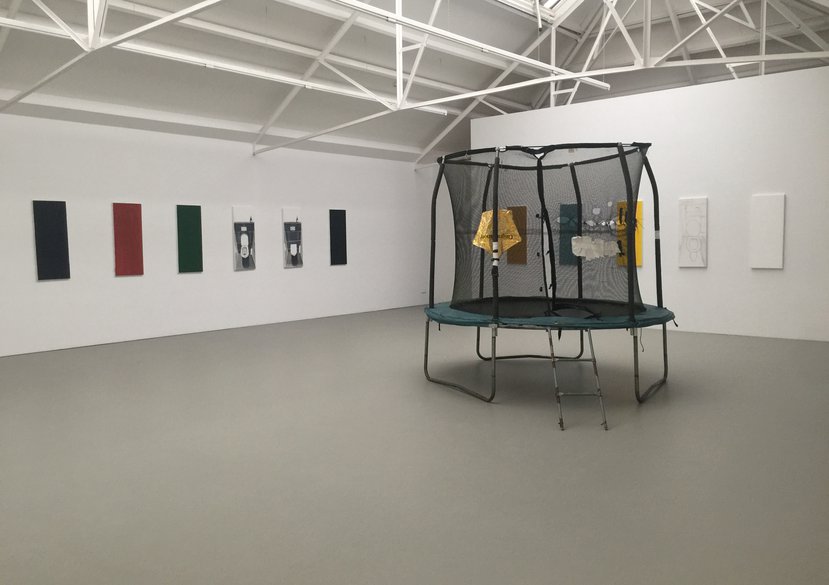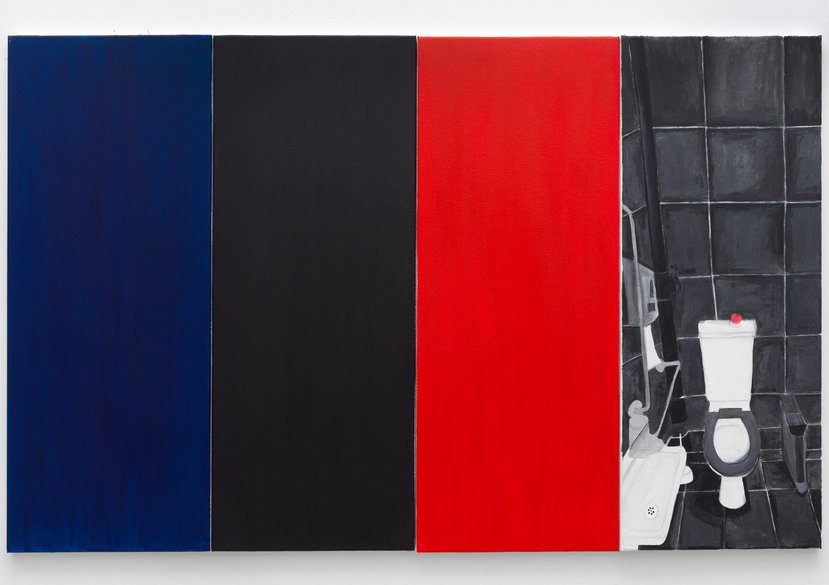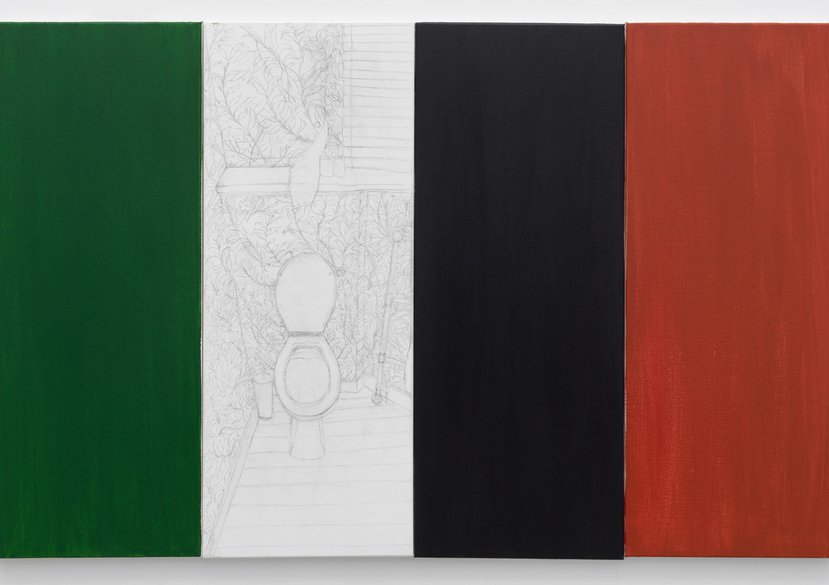
Room After Woolf: A practice-based investigation into the boundaries of domestic space, creative production, and gender.
I thought how unpleasant it is to be locked out; and I thought how it is worse perhaps to be locked in.
Virginia Woolf (2016:23)
My research explores how a consideration of contemporary artists' practices, in particular their embodied experiences of creative production and physical space, might shed new light on Virginia Woolf's A Room of One's Own (1929). The PhD maps artists' work and methodologies onto specific domestic spaces/rooms as a means of locating them within the home; it also uses various feminist strategies to straddle and unpick dominant cultural expectations and norms of gender roles, particularly with regards to work and domestic labour.
My written submission is mapped like a home. For each chapter I have allocated artistic mediums to domestic space, specific rooms in the home — by mapping artists’ media and methodology onto domestic spaces, the research can move through the home, through the dominant expectations of gender roles and question the different feminist strategies in relation to art production. To clarify what I mean by feminist I modify American curator Helen Molesworth’s (b.1966) definition, which she adapted from American scholar Peggy Phelan’s (b.1959) Survey essay, which was published in Art and Feminism in 2001.
It is a challenge to the persistent organization of the world through the category of gender that consistently privileges men. The second is that feminism privileges self-criticality (as opposed to self-expression, per se) in political, aesthetic, and intellectual practice.[1]
My practice, influenced by both Phelan and Molesworth’s definitions, constitutes an exploration into the boundaries of physical and mental space, creative production, and gender. Encompassing film, drawing, painting, photography, performance, installation and text, and is rooted in an investigation of everyday life, whilst continuously documenting my own story. The work manifests in exhibitions, screenings and performances, sometimes all three in different forms. Portraiture is primary to my practice across media and form. In 2005 I made a series of 16mm films comprising fixed shots of the interiors of specific homes I was familiar with, which I saw as portraits of the inhabitants’ dwelling. I continue to make portraits through painting and drawing, whether of someone’s living space, bathroom, the faces of friends, or my own daughter. In my video works, I employ the method of montage that enables me to juxtapose portraits across moving images, text, photographs, paintings or drawings that together depict my life. In the home, there is the juxtaposition of different spaces with different purposes, environments, and atmospheres, as well as different relationships to the other inhabitants of the home, in my work I move between these roles and rooms and so the notion of the ‘room’ allows me to think metaphorically but also about the practical day to day of living, being, a woman, a mother.
[1] Butler, Cornelia, and Lisa Gabrielle Mark, (Ed). WACK!: Art and the Feminist Revolution. Los Angeles: Cambridge, Mass: MIT Press, 2007 pg.429.
Key details
School, Centre or Area
Supervisors
Gallery
More about Juliette
Biography
Juliette Blightman is a British artist, working with various media and forms. By not using a singular model or formula, but rather drawing from personal experience, her artworks emerge as a response and manifest in exhibitions that incorporate painting, drawing, photography, text, installation and moving image, often involving the viewer in her daily life while reflecting on the self, amidst the backdrop of broader world events. Blightman investigates the boundaries of physical and mental space, creative production, and gender and has exhibited in the UK and internationally, most recently she has exhibited alongside American artist Dorothy Iannone at Arcadia Missa, London, Kölnischer Kunstverein, Cologne and the Vleeshal Centre for Contemporary Art in Middelburg. Her performances and video works have been presented in the Fridericianum, Kassel, Hayward Gallery, London, Kölnischer Kunstverein, Cologne, Kunsthaus Bregenz and at the Institute of Contemporary Arts, London. She has taught widely in a number of institutions in the UK, Europe and America since 2009, these include the Royal College of Art, Camberwell College of Art, ArtsCenter, Los Angeles; UdK Berlin and Künstakademie Düsseldorf.
Degrees
2017 - 2022 PhD Candidate by Fine Art Practice, Royal College of Art, London
2007 MA Fine Art, Byam Shaw School of Art/Central St Martins at University of the Arts, London
Awards
2016 - Prix K-Way Per4m, Artissima International Fair of Contemporary Art Turin, Italy
Presentation – Young Acquisitions for Museum Ludwig, Gesellschaft für Moderne Cologne, Germany
2014 - Shortlisted for the 2015 Ars Viva Prize for Fine Arts Fürstenberg Zeitgenössisch Stipendium 2014
2012 - Shortlisted for the Contemporary Art Society Commission to Collect Annual Award
CCA Andratx, Mallorca, Artist Residency, 4 weeks
2011 - Munich Kunstzeitraum, Artist Residency, 6 months
2010 - Irish Museum of Modern Art, Artist Residency, 2 months
2008 - Künstlerhäuser Worpswede, Artist Residency, 3 months
Funding
2018 - TECHNE Doctoral Training Partnership, Arts and Humanities Research Council (AHRC)
Publications
2021 (Ta)Rot. Tarot. Dorothy Iannone. Juliette Blightman (cat.) Supported by Koelnischer Kunsteverein, Cologne and Vleeshal, Middelburg. Text: Nikola Dietrich (E), Michael Glasmeier, Roos Gortzak (E) and Amelia Stein Conzept: Gregorio Magnani and Graphic: Wolfe Hall Studios, London Koenig Books Edition: 500
2018 'Scripts, Descriptions and Texts 2011-2016', published by Koenig Books, Supported by Kunsthalle Bern. Kunsthalle Bern, Valérie Knoll, Geraldine Tedder Text: Tenzing Barshee, Kirsty Bell, Valérie Knoll (E) Graphic: Robin Watkins 15 × 24 cm, 264 pages, Softcover Koenig Books Edition: 750
2017 Loved an Image, Published by saxpublishers, Graphic: saxpublishers, 15 × 21.5 cm, 100 pages, Softcover saxpublishers, Vienna, Edition: 150
Juliette Blightman’s artist book Loved an Image combines three of the artist’s practices: performance, video and drawing/painting. Structured as abstract conversation and guide through a personal relationship, the book consists of black pages with one-phrase subtitle-like writings, taken out of Blightman’s films, performances and everyday conversations, combined with cacti drawings.
2011 'Scripts and Descriptions 2005-2010', published by Koenig Books, Graphic: Robin Watkins, 15 × 24 cm, 112 pages, Softcover Koenig Books, Edition: 750
2011 ‘all those, too, who are sustained by the alternative hopes’, published by International Project Space, Bournville, Graphic: Robin Watkins, Supported by; Arts Council England/Birmingham City University/The Elephant Trust, Edition: 500
Conferences
2021 Queer Materialism Research Day, Kingston University, London
2020 Afternoons in June, Royal College of Art, London, Greenwich University, London and NAFAE network
2019 Auto-Fiction, Royal College of Art, London
Speaking with: Carol Mavor and Nadia Hebson, Royal College of Art, London
Research Group Present: Ali Smith, Royal College of Art, London
Say Something Back, Merton College, Oxford University


